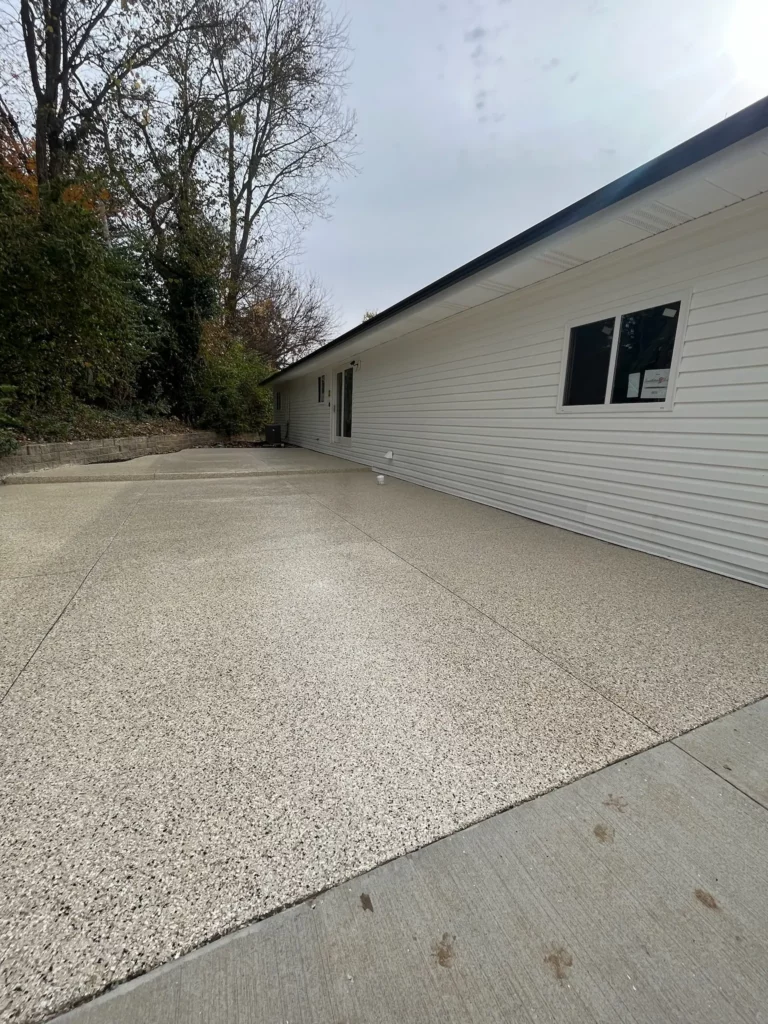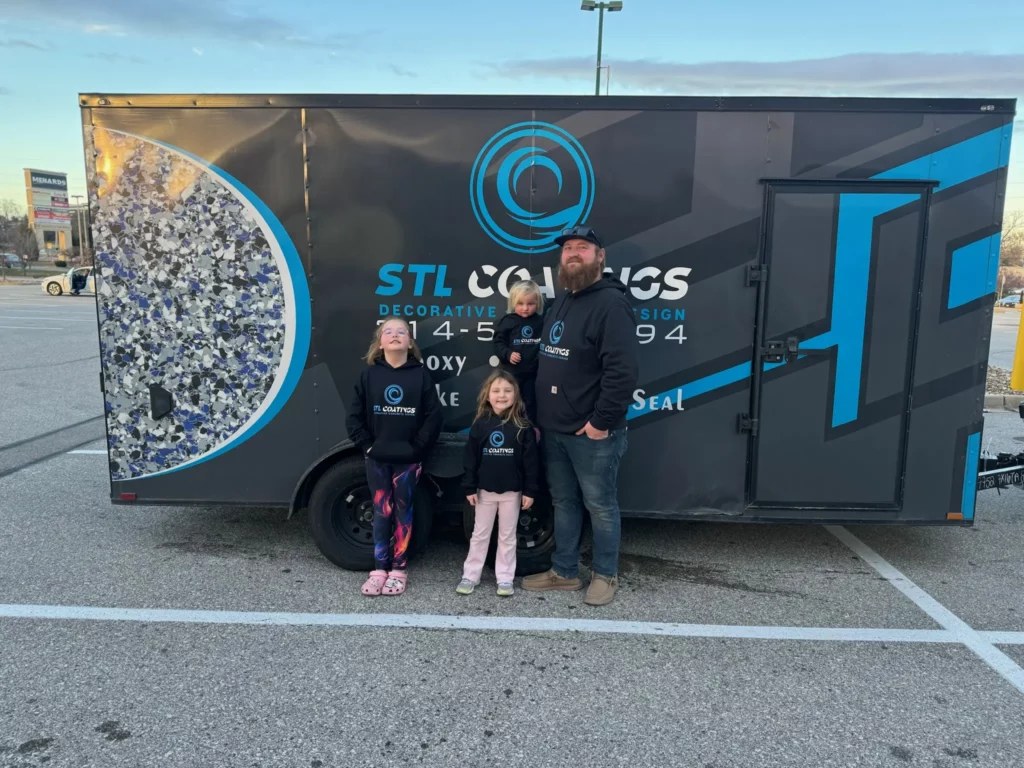When exploring decorative epoxy options for your garage, basement, or commercial space, two names pop up a lot: flake and quartz epoxy flooring. If you’re comparing flake vs quartz epoxy flooring for your Chesterfield property, understanding the difference between the two is key. Each system has its own strengths, aesthetic appeal, and best-use scenarios.
And if you’re working with a local team like STL Coatings, you can expect expert recommendations tailored to your space’s function and style.
What Is Flake Epoxy Flooring?
Flake epoxy flooring—sometimes called chip or broadcast flake—is made by embedding decorative vinyl flakes into a pigmented epoxy base. These flakes come in various sizes and color blends, and after being spread across the floor, they’re sealed in with a clear topcoat.
The result? A lightly textured, multi-colored floor that hides dirt, adds grip, and looks sharp in just about any environment.
Ideal for:
- Residential garages
- Commercial spaces
- Showrooms
- Retail and office areas

What Is Quartz Epoxy Flooring?
Quartz epoxy uses colored quartz sand instead of vinyl flakes. The sand is broadcast into the epoxy or polyaspartic base coat and then layered again with a resin topcoat. This system creates a more uniform, fine-grain texture and is often used in high-performance or industrial environments.
It combines the best of visual appeal and industrial-grade durability.
Ideal for:
- Commercial kitchens
- Locker rooms and restrooms
- Healthcare and veterinary clinics
- Industrial warehouses and food production facilities
Main Differences at a Glance
| Feature | Flake Epoxy | Quartz Epoxy |
|---|---|---|
| Texture | Light, subtle grip | More abrasive and slip-resistant |
| Appearance | Colorful, speckled look | Uniform, fine-grain finish |
| Durability | Great for everyday use | Built for extreme wear and chemicals |
| Cleaning | Easy to clean | Also easy, but holds up better to aggressive scrubbing |
| Cost | Slightly more budget-friendly | Higher cost due to extra material and labor |
Aesthetic Appeal: Speckled vs. Smooth Uniformity
Flake systems offer more visual variety. Think of them like epoxy flooring confetti—fun, colorful, and great at hiding dirt. They’re perfect if you want something with personality and a modern finish.
Quartz, on the other hand, has a cleaner, more minimalist look. It’s often used when safety and consistency matter more than bold visuals. If your space leans toward sleek and professional, quartz might be the winner.
Texture and Traction
If you’re concerned about slip resistance, both options are solid—but quartz has the edge.
- Flake systems provide light traction that’s great for residential or light commercial use.
- Quartz systems are inherently rougher and more abrasive, which helps in areas that see spills, water, or grease.
That added grip makes quartz a favorite for kitchens, bathrooms, or anywhere wet shoes are a given.
Durability Under Pressure
Both systems are far tougher than standard coatings or paints. But when you start dealing with forklifts, hot tire pickup, or aggressive cleaning chemicals, quartz flooring wins.
- Flake epoxy resists wear and tear well, but isn’t built for industrial loads or regular scrubbing with degreasers.
- Quartz epoxy handles impacts, chemicals, and heat better, making it ideal for commercial and healthcare applications.
Installation Differences
Flake systems are typically easier and faster to install. You’re looking at:
- 1–2 coats of epoxy or polyaspartic
- Flake broadcast
- Clear topcoat
Quartz takes a little more time and precision:
- Primer layer
- Broadcast quartz into epoxy
- Optional second broadcast layer
- Multiple topcoats for sealing and durability
The extra labor and material make quartz systems more expensive—but also more robust.
Where You’ll See Each One in Chesterfield
You’ll find flake epoxy systems in homes and garages all across town. They’re especially popular in neighborhoods with finished garages or flex rooms. These floors hold up to daily wear and still look great.
Quartz systems? You’ll see them behind the scenes at restaurants, in local medical clinics, and any facility with heavy-duty demands. They’re all about longevity and function.
And while we’re on the topic of balancing beauty and performance—take a walk through Central Park in Chesterfield. It’s a great reminder that thoughtful design doesn’t have to sacrifice durability. The same goes for your floor.

Cost Comparison
Flake epoxy flooring typically ranges from $4–$7 per square foot, depending on:
- Number of coats
- Flake density and size
- Type of topcoat used
Quartz systems usually fall in the $7–$12 per square foot range, driven up by:
- Double broadcast layers
- Multiple topcoats
- Thicker applications
Both systems are cost-effective over time due to minimal maintenance and long lifespans.
Which One Is Right for You?
Ask yourself a few quick questions:
- Do you want more color and style variety? → Flake
- Do you need industrial-grade strength and grip? → Quartz
- Is your space exposed to a lot of water, oils, or foot traffic? → Quartz
- Are you coating a garage, basement, or storefront with moderate wear? → Flake
Final Thoughts
Both flake and quartz epoxy flooring systems are excellent choices—just for slightly different reasons. Flake brings color, comfort, and casual durability. Quartz brings performance, strength, and safety.
And whichever way you lean, STL Coatings can help you make the right call and execute the install like pros.
Because whether your space is built for heavy-duty use or just heavy weekend projects, the right floor makes all the difference—and it doesn’t have to choose between looking great and holding up to life in Chesterfield.
